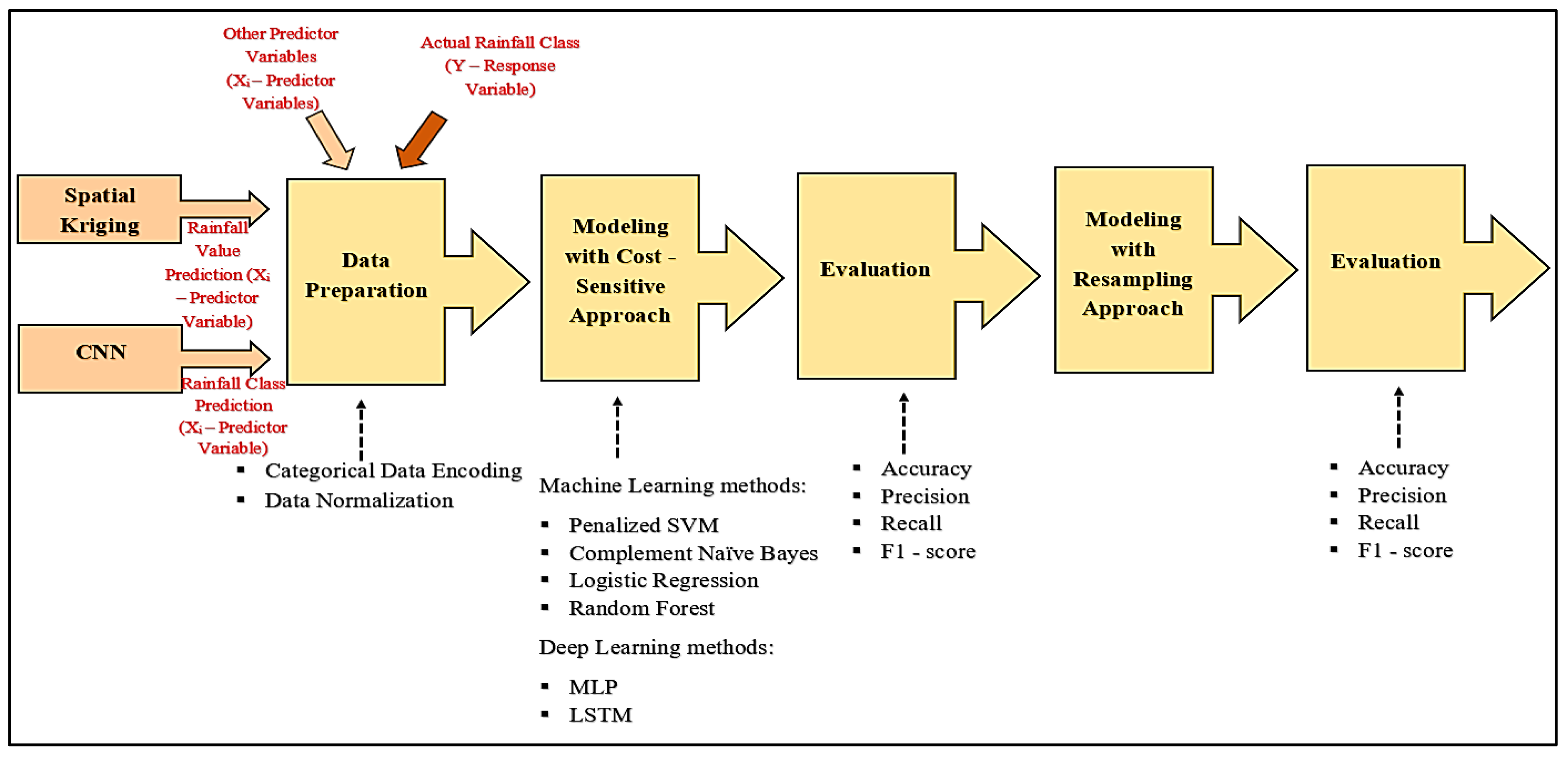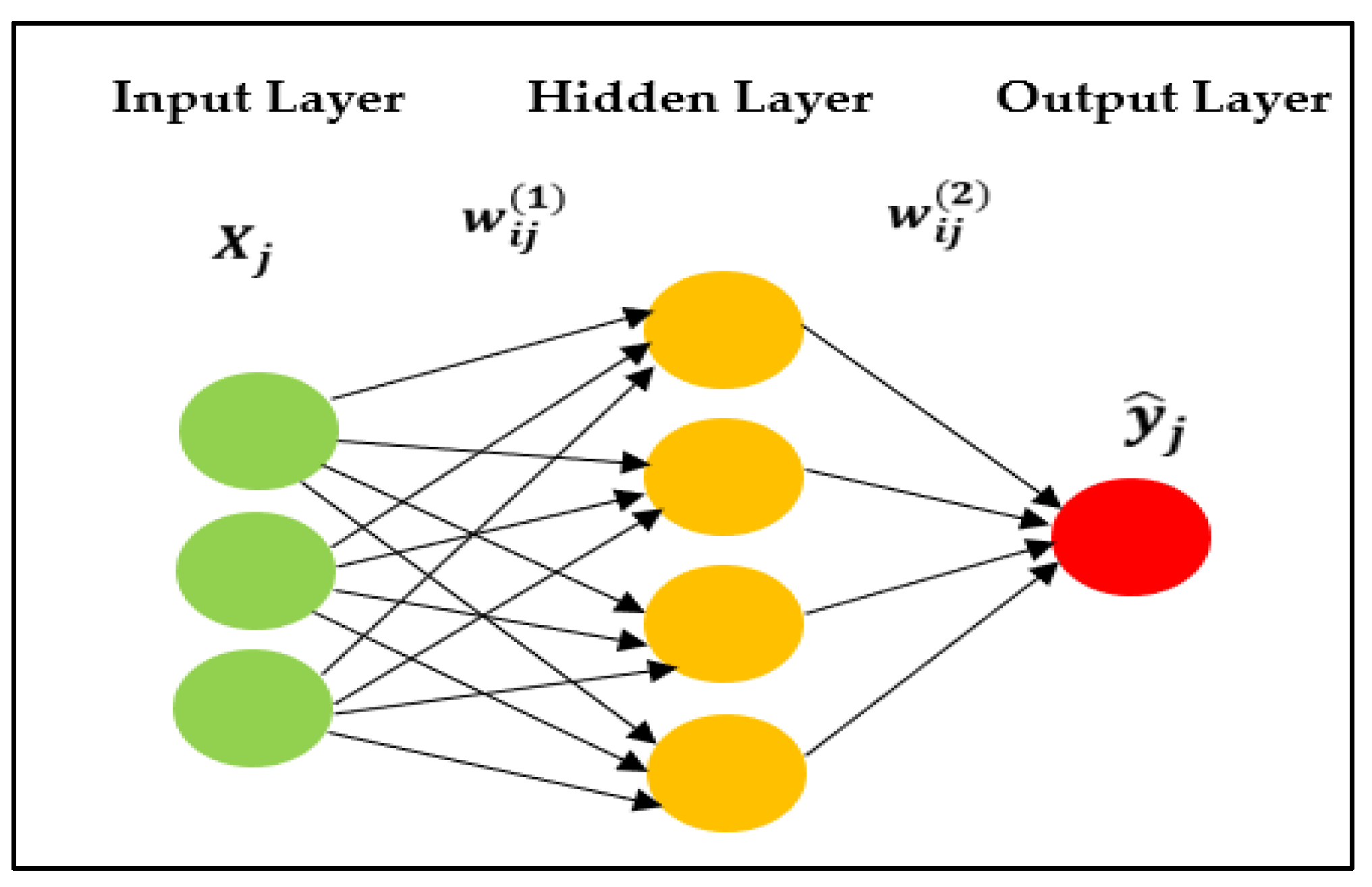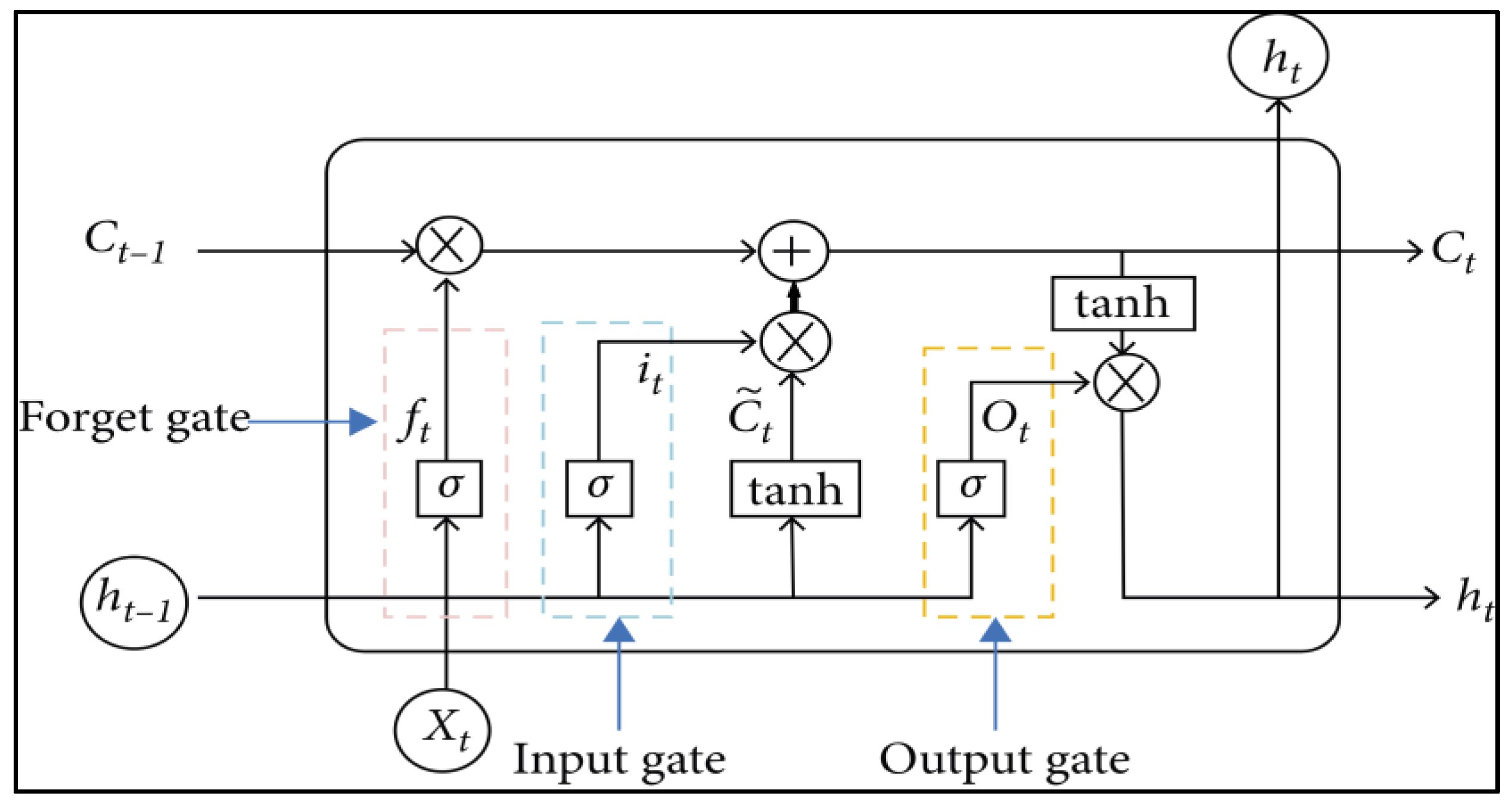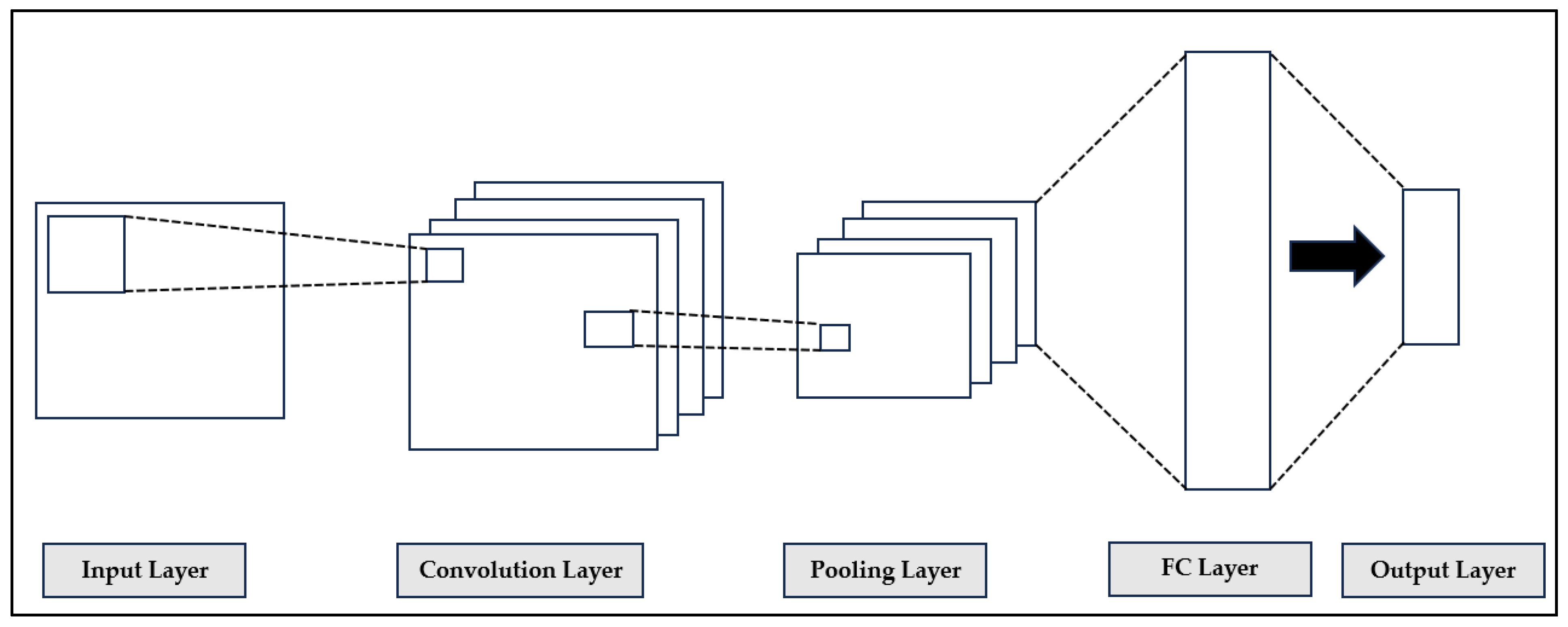An Application of Ensemble Spatiotemporal Data Mining Techniques for Rainfall Forecasting †
Abstract
1. Introduction
2. Materials and Methods
2.1. Description of Data
2.2. Methods
2.2.1. Spatial Kriging
2.2.2. Multi-Layer Perceptron (MLP)
2.2.3. Long Short-Term Memory (LSTM)
2.2.4. Convolutional Neural Network (CNN)
2.2.5. Random Forest (RF)
2.2.6. Support Vector Machine (SVM)
2.2.7. Naïve Bayes (NB)
2.2.8. Multinomial Logistic Regression (MLR)
2.3. Imbalanced Learning
2.3.1. Cost—Sensitive Learning
2.3.2. Resampling Techniques
2.4. Model Evaluation
3. Results and Discussion
4. Conclusions
Author Contributions
Funding
Institutional Review Board Statement
Informed Consent Statement
Data Availability Statement
Acknowledgments
Conflicts of Interest
References
- Hussein, E.A.; Ghaziasgar, M.; Thron, C.; Vaccari, M.; Jafta, Y. Rainfall Prediction Using Machine Learning Models: Literature Survey. In Artificial Intelligence for Data Science in Theory and Practice; Studies in Computational, Intelligence; Alloghani, M., Thron, C., Subair, S., Eds.; Springer: Cham, Switzerland, 2022; Volume 1006. [Google Scholar] [CrossRef]
- Parmar, A.; Mistree, K.; Sompura, M. Machine Learning Techniques For Rainfall Prediction: A Review. In Proceedings of the 2017 International Conference on Innovations in information Embedded and Communication Systems (ICIIECS), Coimbatore, India, 17–18 March 2017. [Google Scholar]
- Sun, D.; Wu, J.; Huang, H.; Wang, R.; Liang, F.; Xinhua, H. Prediction of Short-Time Rainfall Based on Deep Learning. Math. Probl. Eng. 2021, 2021, 6664413. [Google Scholar] [CrossRef]
- Kannan, S.; Ghosh, S. Prediction of daily rainfall state in a river basin using statistical downscaling from GCM output. Stoch. Environ. Res. Risk Assess. 2010, 25, 457–474. [Google Scholar] [CrossRef]
- Ji, S.-Y.; Sharma, S.; Yu, B.; Jeong, D.H. Designing a rule-based hourly rainfall pre-diction model. In Proceedings of the 2012 IEEE 13th International Conference on Information Reuse & Integration (IRI), Las Vegas, NV, USA, 8–10 August 2012; Volume I. [Google Scholar] [CrossRef]
- Sharma, M. Comparative Study of rainfall forecasting models MA Sharma. JB Singh N. Y. Sci. J. 2011, 4, 115–120. [Google Scholar]
- Gao, L.; Wei, F.; Yan, Z.; Ma, J.; Xia, J. A Study of Objective Prediction for Summer Precipitation Patterns Over Eastern China Based on a Multinomial Logistic Regression Model. Atmosphere 2019, 10, 213. [Google Scholar] [CrossRef]
- Aguasca-Colomo, R.; Castellanos-Nieves, D.; Méndez, M. Comparative Analysis of Rainfall Prediction Models Using Machine Learning in Islands with Complex Orography: Tenerife Island. Appl. Sci. 2019, 9, 4931. [Google Scholar] [CrossRef]
- Zainudin, S.; Jasim, D.; Abu Bakar, A. Comparative Analysis of Data Mining Techniques for Malaysian Rainfall Prediction. Int. J. Adv. Sci. Eng. Inf. Technol. 2016, 6, 1148. [Google Scholar] [CrossRef]
- Singh, G.; Kumar, D. Hybrid Prediction Models for Rainfall Forecasting. In Proceedings of the 2019 9th Inter-national Conference on Cloud Computing, Data Science & Engineering (Confluence), Noida, India, 10–11 January 2019; pp. 392–396. [Google Scholar] [CrossRef]
- Oswal, N. Predicting rainfall using machine learning techniques. arXiv 2019, arXiv:1910.13827. [Google Scholar]
- Katrakazas, C.; Antoniou, C.; Yannis., G. Time Series Classification Using Imbalanced Learning for Real-Time Safety Assessment. In Proceedings of the Transportation Research Board 98th Annual Meeting, Washington, DC, USA, 13–17 January 2019. [Google Scholar]
- Cuenca, J.; Correa-Flórez, C.; Patino, D.; Vuelvas, J. Spatio-Temporal Kriging Based Economic Dispatch Problem Including Wind Uncertainty. Energies 2020, 13, 6419. [Google Scholar] [CrossRef]
- Abirami, S.P.; Chitra, P. Chapter Fourteen—Energy-efficient edge based real-time healthcare support system. Adv. Comput. 2020, 117, 339–368. [Google Scholar]
- Grosse, R. Lecture 5: Multilayer Perceptrons. 2018. Available online: https://www.cs.toronto.edu/~rgrosse/courses/csc321_2018/readings/L05%20Multilayer%20Perceptrons.pdf (accessed on 1 February 2023).
- Understanding LSTM Networks. Available online: https://colah.github.io/posts/2015-08-Understanding-LSTMs/ (accessed on 1 February 2023).
- Lu, W.; Li, J.; Li, Y.; Sun, A.; Wang, J. A CNN-LSTM-Based Model to Forecast Stock Prices. Complexity 2020, 2020, 6622927. [Google Scholar] [CrossRef]
- How Do Convolutional Layers Work in Deep Learning Neural Networks? Available online: https://machinelearningmastery.com/convolutional-layers-for-deep-learning-neural-networks/ (accessed on 1 February 2023).
- Torres, J.F.; Hadjout, D.; Sebaa, A.; Martínez-Álvarez, F.; Troncoso, A. Deep Learning for Time Series Forecasting: A Survey. Big Data. Feb. 2018, 2021, 3–21. [Google Scholar] [CrossRef]
- Goehry, B.; Yan, H.; Goude, Y.; Massart, P.; Poggi, J.M. Random Forests for Time Series. REVSTAT Stat. J. 2021. accepted. Available online: https://revstat.ine.pt/index.php/REVSTAT/article/view/400 (accessed on 1 February 2023).
- Fawagreh, K.; Gaber, M.; Elyan, E. Random Forests: From Early Developments to Re-cent Advancements. Syst. Sci. Control. Eng. 2014, 2, 602–609. [Google Scholar] [CrossRef]
- Yu, N.; Haskins, T. KNN, An Underestimated Model for Regional Rainfall Forecasting. arXiv 2021, arXiv:2103.15235. [Google Scholar]
- Cost-Sensitive SVM for Imbalanced Classification. Available online: https://machinelearningmastery.com/cost-sensitive-svm-for-imbalanced-classification/ (accessed on 2 February 2023).
- How to Handle Imbalanced Classes in Machine Learning. Available online: https://elitedatascience.com/imbalanced-classes (accessed on 2 February 2023).
- Complement Naive Bayes (CNB) Algorithm. Available online: https://www.geeksforgeeks.org/complement-naive-bayes-cnb-algorithm/ (accessed on 2 February 2023).
- Kwak, C.; Clayton-Matthews, A. Multinomial logistic regression. Nurs. Res. 2002, 51, 404–410. [Google Scholar] [CrossRef] [PubMed]
- Hashimoto, E.M.; Ortega, E.M.M.; Cordeiro, G.M.; Suzuki, A.K.; Kattan, M.W. The multinomial logistic regression model for predicting the discharge status after liver transplantation: Estimation and diagnostics analysis. J. Appl. Stat. 2019, 47, 2159–2177. [Google Scholar] [CrossRef] [PubMed]
- Andersson, M. Multi-Class Imbalanced Learning for Time Series Problem: An Industrial Case Study. Master’s Dissertation, Uppsala University, Uppsala, Sweden, 2020. Available online: http://urn.kb.se/resolve?urn=urn:nbn:se:uu:diva-412799 (accessed on 2 February 2023).




| Metric | RMSE | MAE | R2 |
|---|---|---|---|
| Error | 16.2 | 6.64 | 30.3% |
| Parameters | CNN | MLP | LSTM |
|---|---|---|---|
| Activation function | Softmax | Softmax | Softmax |
| Epochs | 50 | 50 | 50 |
| Number of hidden layers | 7 | 2 | 1 |
| Number of neurons in final dense function | 3 | 3 | 3 |
| Batch size | 72 | 72 | 72 |
| Kernel size | (3,3) | - | - |
| Learning rate | 0.01 | 0.01 | 0.01 |
| Optimizer | Adam | Adam | Adam |
| Loss Function | Categorical Cross Entropy | Categorical Cross Entropy | Categorical Cross Entropy |
| Metric | Cost-Sensitive Model | ||||||
|---|---|---|---|---|---|---|---|
| PSVM (Kernel = rbf) | PSVM (Kernel = Poly) | CNB | MLR | RF | MLP | LSTM | |
| Accuracy | 0.75 | 0.73 | 0.71 | 0.74 | 0.73 | 0.73 | 0.73 |
| Recall | 0.75 | 0.74 | 0.72 | 0.74 | 0.74 | 0.74 | 0.74 |
| Precision | 0.75 | 0.73 | 0.71 | 0.74 | 0.73 | 0.73 | 0.73 |
| F1-Score | 0.75 | 0.73 | 0.71 | 0.73 | 0.73 | 0.73 | 0.73 |
| Metric | Cost-Sensitive Model | ||||||
|---|---|---|---|---|---|---|---|
| PSVM (Kernel = rbf) | PSVM (Kernel = poly) | CNB | MLR | RF | MLP | LSTM | |
| Accuracy | 0.71 | 0.77 | 0.68 | 0.81 | 0.76 | 0.70 | 0.71 |
| Precision | 0.72 | 0.75 | 0.75 | 0.79 | 0.75 | 0.72 | 0.75 |
| Recall | 0.71 | 0.77 | 0.68 | 0.81 | 0.76 | 0.70 | 0.71 |
| F1-Score | 0.72 | 0.76 | 0.71 | 0.78 | 0.75 | 0.71 | 0.73 |
| Metric | Cost-Sensitive Resampled Model | ||||
|---|---|---|---|---|---|
| PSVM (Kernel = rbf) | PSVM (Kernel = Poly) | MLR | RF | LSTM | |
| Accuracy | 0.82 | 0.83 | 0.80 | 0.87 | 0.77 |
| Precision | 0.82 | 0.82 | 0.79 | 0.87 | 0.78 |
| Recall | 0.82 | 0.83 | 0.80 | 0.87 | 0.79 |
| F1-Score | 0.82 | 0.83 | 0.80 | 0.87 | 0.77 |
| Metric | Cost-Sensitive Resampled Model | ||||
|---|---|---|---|---|---|
| PSVM (Kernel = rbf) | PSVM (Kernel = Poly) | MLR | RF | LSTM | |
| Accuracy | 0.82 | 0.82 | 0.79 | 0.87 | 0.78 |
| Precision | 0.82 | 0.83 | 0.79 | 0.88 | 0.79 |
| Recall | 0.82 | 0.83 | 0.80 | 0.88 | 0.79 |
| F1-Score | 0.82 | 0.83 | 0.79 | 0.88 | 0.78 |
Disclaimer/Publisher’s Note: The statements, opinions and data contained in all publications are solely those of the individual author(s) and contributor(s) and not of MDPI and/or the editor(s). MDPI and/or the editor(s) disclaim responsibility for any injury to people or property resulting from any ideas, methods, instructions or products referred to in the content. |
© 2023 by the authors. Licensee MDPI, Basel, Switzerland. This article is an open access article distributed under the terms and conditions of the Creative Commons Attribution (CC BY) license (https://creativecommons.org/licenses/by/4.0/).
Share and Cite
Saubhagya, S.; Tilakaratne, C.; Mammadov, M.; Lakraj, P. An Application of Ensemble Spatiotemporal Data Mining Techniques for Rainfall Forecasting. Eng. Proc. 2023, 39, 6. https://doi.org/10.3390/engproc2023039006
Saubhagya S, Tilakaratne C, Mammadov M, Lakraj P. An Application of Ensemble Spatiotemporal Data Mining Techniques for Rainfall Forecasting. Engineering Proceedings. 2023; 39(1):6. https://doi.org/10.3390/engproc2023039006
Chicago/Turabian StyleSaubhagya, Shanthi, Chandima Tilakaratne, Musa Mammadov, and Pemantha Lakraj. 2023. "An Application of Ensemble Spatiotemporal Data Mining Techniques for Rainfall Forecasting" Engineering Proceedings 39, no. 1: 6. https://doi.org/10.3390/engproc2023039006
APA StyleSaubhagya, S., Tilakaratne, C., Mammadov, M., & Lakraj, P. (2023). An Application of Ensemble Spatiotemporal Data Mining Techniques for Rainfall Forecasting. Engineering Proceedings, 39(1), 6. https://doi.org/10.3390/engproc2023039006






